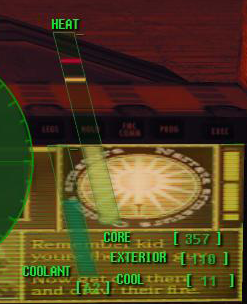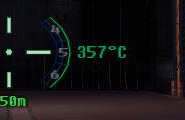Heat


Heat is a waste by-product of firing weapons, using Jump Jets or specialized equipment like MASC or the aerospace afterburner. Heat buildup is harmless until your asset exceeds the yellow line, at which point the asset's weapons are locked out and it reveals the asset's location to all enemies that are currently using active radar. Overheating into the red-zone will trigger an AutoShutDown for ground assets, and will deal massive armor and heat sink damage to all assets.
Heat Sinks help your asset dissipate heat. The rate at which heat is dissipated depends on a few factors:
- The number of heat sinks your asset has. More heat sinks means more dissipation per second.
- The current map. Maps have two different heat variables: Ambient temperature - Determines how hot one's asset will be once all of its heat has dissipated, it's baseline level of heat. Conductivity - Determines how quickly heat will dissipate. Just because a map is cold, doesn't mean that one's asset will cool quickly. For example: SiriusV has a rather cold ambient temperature of -50° but pilots will find their assets cooling about 20% slower than on normal temperature maps, due to low conductivity. Conductivity and temperature aren't uniform over the entire map on every map either. Many maps have water, which has a high rate of conductivity. Some maps, like Scorched have colder temperatures at higher elevations.
- Your total heat. When your total heat is higher, it will dissipate faster.
- Your current movement. Remaining stationary enables for faster cooling.
- Moving into deep water will dramatically improve heat sink efficiency, watch out, it also slows down everything's movement speed by 20% except for hovers and aircraft.
- Whether your asset is powered down or online, powered down assets cool faster.
- Your heat sink health. Damaged heat sinks cool more slowly.
Overheating too often can damage your heat sinks, rendering them ineffective.
You can Flush Coolant to rapidly exchange heat with your surroundings by pressing the [ C ] key. However, your asset carries a limited amount of coolant, so use it wisely. Be aware that when in lava, like on TC_Inferno, using coolant will still exchange heat, but will cause your asset to increase in temperature instead of cool.
Coolant is refilled whenever you repair your asset, and damaged heat sinks will also be repaired.
Heat Management
- Every ground asset has automatic overheat protection also known as 'AutoShutDown' - when it kicks in, your vehicle will shut down to dissipate heat more rapidly and to prevent damage from excessive heat.
- AutoShutDown can be disabled by pressing the [ H ] key. This allows the asset to continue to operate. It also unlocks the asset's weapons and JJ equipment that would otherwise be unusable when at high levels of heat. It also increases the amount of damage that heat sinks take when overheating.
- AutoShutDown is a toggle - pressing it a second time will disengage the override.
(bypassing AutoShutDown and crossing the upper temperature threshold, will cause the unit to shutdown and remain energy less for 2 seconds while inflecting damage to your unit.)
- Alternatively, find cover and stay there until your asset cools down.
- All assets in MWLL (with the exception of the Anubis and some Archangels) come equipped with a limited supply of coolant. You can perform a coolant flush by pressing the [ C ] key, which will rapidly reduce some of your heat. Coolant works like a heat exchanger and functions most efficiently when the heat bar is high. Beware of lava, using coolant in lava will heat up the asset instead of cooling it.
- Utilizing the Chainfire fire mode can help curb heat spikes from firing high-heat weapons.
- Also, if there's a large body of water nearby, jumping in will aid your heat efficiency depending on how immersed in the water you are -- if the water completely covers you, your heat dissipation increases dramatically.
- For assets with many, smaller high heat weapons, like Heavy Medium Lasers, it is most heat efficient to chain fire and keep the heat level close to the yellow line. This will maximize heat dissipation and maximize DPS, all without causing major damage.
Coolant
A limited supply of coolant is carried by all 'mechs and vehicles with the exception of the Anubis and any other asset equipped with stealth armor. Coolant can be flushed by pressing the [C] key. Flushing coolant will very rapidly disperse heat generated by the vehicle or battlemech.
Usage:
- Sip Coolant - The best way to use coolant. Tap [C] briefly in order to stay below the yellow line, or at least, the red line. This can be done in response to heat after overheating (from one's own weapons or from enemy Flamers) or this can be done preemptively before using more weapons or Jump Jets. Sipping coolant is the most effective way to use coolant when retreating urgently with MASC.
- Drink Coolant - Much less efficient. Press and hold [C] longer to prepare for using a high-heat alpha strike or for very high-heat weapons like HPPC.
NOTE: Coolant will automatically refill upon repair, before armor begins to be replaced. A full tank, from 0% remaining, costs 1,000 C-Bills. The more coolant remaining when repairs begin, the less it costs to refill, for example, it only costs 250 C-Bills to refill from 75% coolant remaining.
NOTE: Coolant increases the heat exchange rate with one's surroundings making coolant use on cold maps more effective, less effective on hot maps, and fatal when in lava.
Canon
RADICAL HEAT SINKS
Introduced: 3122 (Federated Suns) More properly known as the Reclaimed Coolant Flush Injector, the so-called “radical heat sink” system is, in effect, a logical upgrade to the same coolant pod technology prototyped by the Federated Commonwealth in 3049. Where the original coolant pods proved to be one-shot devices, this system enables the ’Mech or fighter to make more frequent flushes in combat. The repeatability is not without some risk, however. Though the flush lines have been reinforced and better insulated to enable its functions, there exists a significant chance of rupture over time, especially if the warrior relies too heavily on the flush to keep his heat levels under control in an intense firefight. For this reason, many pilots and MechWarriors are cautioned to treat the “radical heat sink” system as if it has a more limited recharge supply, stressing that it be used only in cases of extreme emergency. (Field Manual: 3145, p. 247, "Radical Heat Sinks")
| ||||||||||
